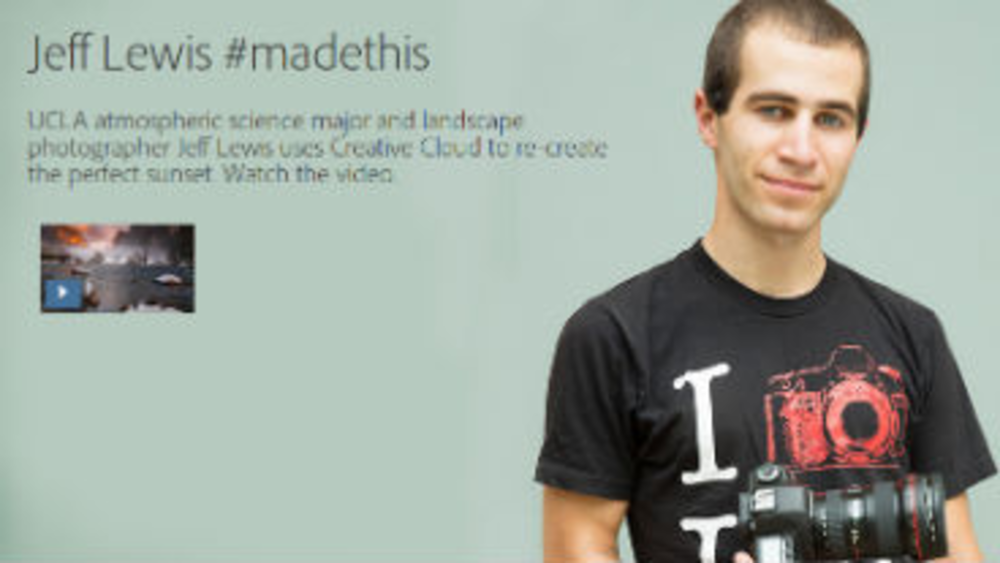The Aim: Adobe doesn’t have much work to do around brand recognition. Its Creative Cloud has little competition, and programs like Photoshop, Illustrator, and InDesign are the undisputed go-tos for creative artists—which is why its latest campaign, “Make it with Creative Cloud,” is focused on education rather than pure awareness.
“Adobe’s products facilitate creativity and innovation, encouraging students to think big and apply their skills to projects that can really impact the world around them,” says AnnMarie Baba, senior marketing manager for student campaigns at Adobe. “Because of the importance of innovation, Adobe places a big emphasis on education; education fosters a new generation of inventors.”
To that end, rather than launch a one-off competition or a short-term campaign, “Make it with Creative Cloud,” is a year-long activation designed to build continued brand loyalty and a deep personal relationship with budding young creatives across a range of disciplines. And there’s no better way to build rabid brand loyalty among student creatives than by highlighting their work and helping them get a job in their field.
“Adobe is telling students that it is the facilitator of creative ambition, and that the company is giving students the tools to create in the real world what’s in their heads,” says Clare Stutchbury, executive client partner at MRY New York, the agency handling the campaign.
The Strategy: Adobe’s integrated effort, which will run throughout the academic year, encompasses a plethora of touchpoints, everything from social and digital display to out-of-home, print, and on-campus outreach.
Students with exceptional skill and promise were selected and filmed earlier this year for a series of mini-documentaries profiling their creative processes and inspirations. The short films were featured on Adobe Web properties and highlighted through a variety of channels, including YouTube, Facebook, Instagram, Twitter, and in relevant retail spaces.
In one profile, a UCLA atmospheric science major and landscape photographer named Jeff Lewis demonstrates how he uses Adobe’s Creative Cloud to shoot breathtaking images of sunsets. Beneath each profile is a list of the different Adobe tools used by the student to create his or her work, which is Jeff’s case is Adobe Photoshop and Lightroom.
In another phase of the campaign, Adobe is partnering with a series of global brands, such an charitable organization (RED), to give students the chance to collaborate with professionals on actual design projects. In the case of (RED), students were given the chance to work with graffiti artist Futura to create the digital album artwork for the nonprofit’s soon-to-be-released compilation album Dance (RED) Save Lives 2, set to go on sale several weeks before World AIDS Day on December 1.
Adobe has also organized a global network of student ambassadors who will remain active on campuses throughout the school year to help generate continued awareness of the Creative Cloud. The student rep program is a way for Adobe to “engage with students on their turf” and give the target audience a chance to mess around and have fun with Adobe products, Stutchbury says.
“It allows for more in-depth product education, conducted in workshop settings, where trained student reps can teach their peers how best to use Adobe Creative Cloud,” she says. “Since our campaign is predicated on peer-to-peer learning, this element was crucial during the campaign planning process.”
Channel Highlight: Considering the target audience—college students—social plays a particularly prominent role in the campaign.
“One of the ways our audience uses social is to seek out peer recognition and validation,” says Josh Hilliard, group strategy director at MRY. “Because of that, we’re using the global Adobe Students Facebook page to showcase some of the top student creatives we’ve found—to highlight not only them and their work, but also their making process.”
MRY did extensive research into the behaviors and consumption habits of its target to ensure, as Hilliard puts it, the campaign and its message would be “internalized by students.” In the same vein, MRY is continually optimizing the way it uses each social channel in order to maximize engagement.
For example, MRY and Adobe found that behind-the-scenes photos of the featured students and their respective creative processes in action resonated and performed extremely well on Instagram, which led them to focus more heavily on that type of content.
“This insight led to a 40% fan growth on Instagram since the beginning of the campaign,” Hilliard says. “Similarly, we learned that our most effective tweets are those that feature visuals of students and their creative work, and that talk about another of our key insights: job readiness.”
The Results: In just six weeks, the “Make it with Creative Cloud” campaign generated more than six million earned impressions, in addition to over four million impressions from media partners, as well as nearly 1,500 trial product downloads.
The Takeaway: “Make it with Creative Cloud” works because of its authentic tone, which, Baba says, speaks to students in a voice and style they can relate to, which is why storytelling—rather than product selling—remains front and center.
“We didn’t want to sound too gimmicky; we wanted students to learn about our products in a way that they could understand and apply to their everyday lives,” Baba says. “We want students to think big in order to make big [and] we hope the images and stories from their peers are inspiring and compel them to explore beyond boundaries.”








